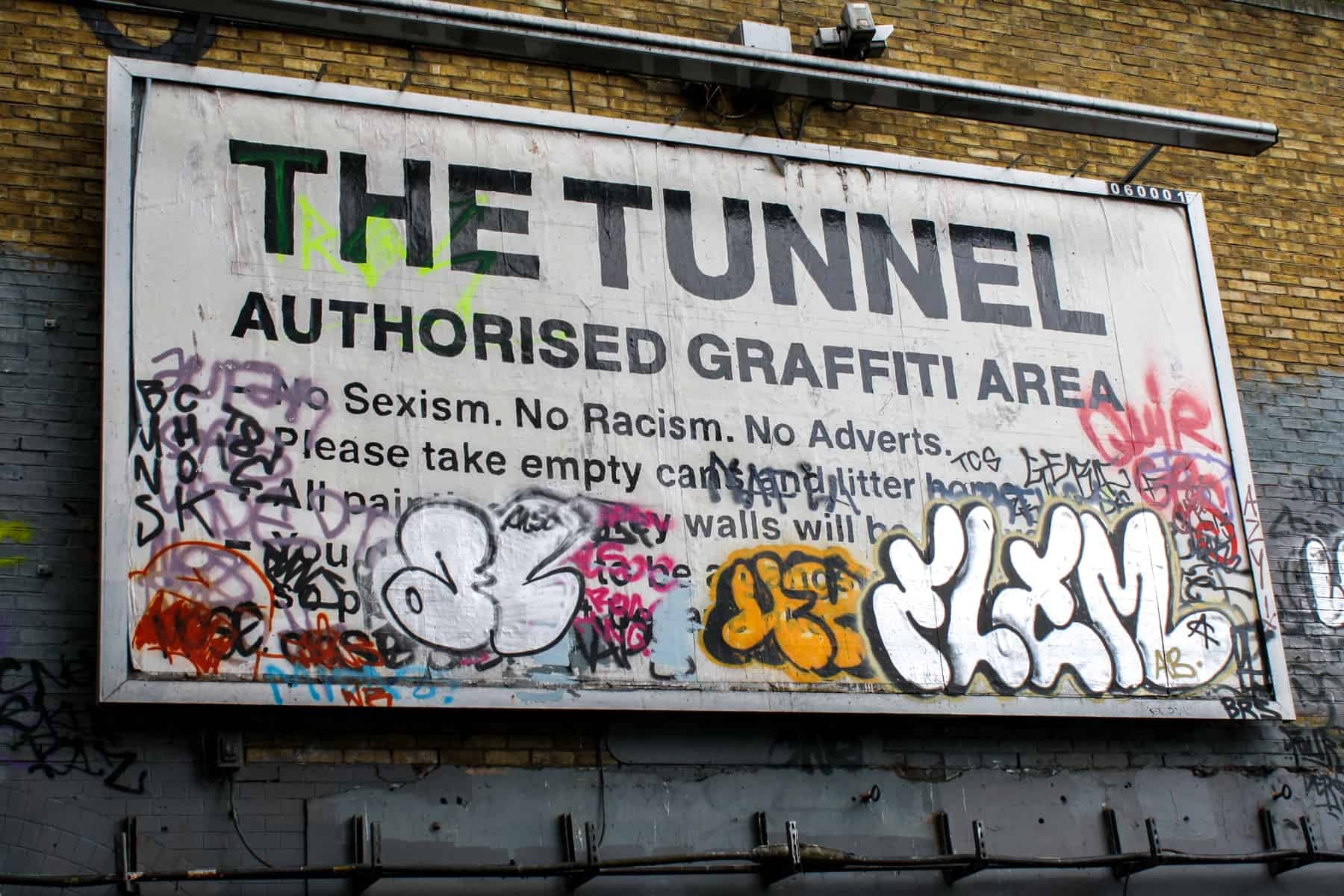Disclaimer: This post contains affiliate links to handpicked partners, including tours, gear and booking sites. If you click through or buy something via one of them, I may receive a small commission. This is at no extra cost to you and allows this site to keep running.
Under Waterloo Station is the London Graffiti Tunnel. A permanent, hidden fixture bypassed by those on the Southbank. Here’s where to find it, and how to see it.
Under Waterloo station’s crowded platform and rumbling tracks is a street artist’s playground. A five-minute walk from the main station exit is Leake Street (just off York Street), which will bring you to an authorised graffiti area known as the hidden Waterloo Station street art tunnel.
It’s a hidden art space in the Leake Street arches, often only stumbled upon by locals and spread through word of mouth.
It’s a permanent fixture hidden from view and casually bypassed by those eagerly seeking the beauty of the Southbank and the London Eye. But it is a space where the creatives come to express themselves with relative freedom.
I’ve been fascinated by this place for years, constantly taking friends down there during their visits to London. Without the art, it would be just another dark, dingy and dirty walkway but instead, it’s filled with colour, political expression, humour and unique design.
It also makes you release that not all graffiti is bad.

London Graffiti Tunnel – Hidden Art at Waterloo Station
Contents
History of the London Graffiti Tunnel
The area was first used by Banksy back in 2008 for an art display with the aim to “transform a dark forgotten filth pit” into “an oasis of beautiful art”.
He kept the location a secret until the unveiling and since then it’s been a canvas for anyone with a paint can to come and dominate a space. Sadly, it no longer lives up to its name of “The Banksy Tunnel” now that his work has been completely covered over.

The entrance sign for the London Graffiti Tunnel.

Graffiti lines one of the Leake Street arches.

One section of the graffiti tunnel under Waterloo Station.
On my last visit to the tunnel, I was lucky enough to see three street artists in action.
I also had an opportunity to chat with one of the artists, Solo, who has been involved in the UK graffiti scene since the late eighties. He paints nearly every day and travels all over the world to do so.

Graffiti artist at work.
Leake Street Tunnel Style
I asked Solo how he defines his style and what it takes for someone to stand out. Each time I’ve been to the tunnel it is completely different and only a small handful of the same images remain intact: “My style is freestyle graf which means I do not draw what I paint but just show up to the wall so I have no idea how it will turn out. I like to mark out letterforms and destroy them in the painting. Some you win, some you don’t.”
Was he doing this as a hobby? My assumption was wrong and I was really surprised to learn that this is actually a full-time job. My only prior thoughts of graffiti are from memories of my brother getting in trouble by my parents for attempting it (to be fair he had the skill) and constantly seeing non-artistic ‘gang’ slogans. Hardly positive.

The gritty, hidden Leake Street tunnel.
London Street Art for a Good Cause
Solo initially got into graffiti through Hip Hop culture and loved writing on anything and everything, but over time has used his art for positive causes. His most recent project has been The Brixton Windmill Restoration mural on Lyham road in conjunction with Positive Arts, an organisation that works with communities in urban areas.
Not only that, but he also had the opportunity to paint the Albert Street School in Johannesburg for refugee children and the Ansty Building working with inner-city children in Johannesburg. And nothing makes me happier than hearing about positive community projects and charitable endeavours.
Graffiti for social good gets my vote.
I was told a piece of work may only last a few days in the dark depths of the Waterloo tunnel before it’s potentially covered over. But I got a glimpse into the feeling an artist gets when they finish their work and can put a proud stamp on it.
Maybe I can step it up a level and get featured in the edgy east enclave of Shoreditch – which is home to the biggest collection of street art in London including more of Banksy’s recent works.
Street art in London is constantly changing, getting bigger and more expressive, and finding new spaces to fill. A good overview of the murals can be found in this picture essay of Shoreditch street art. For those wanting minute detail on artists and hidden corners, check out the recommended Shoreditch Street Art Tours.
Just as the art in the Waterloo tunnel is always evolving, these spaces create a location that is more than a one-time visit. Solo’s work space in Brixton is also awaiting the eager art-appreciating eye.
In the meantime, get down to the Waterloo tunnel – you never know what you might find.

The graffiti showcase continues beyond the tunnel until it reaches a dead end connecting to an old railway bridge.
Street Art Beyond London
Interested in how street art has transformed other cities and why it’s so prevalent, check out my other guides.
- Street Art in Athens – Visual Expressions of a Politically Troubled Greece.
- Things to Do in Linz, Austria – Changing Perceptions of the City of Creative Arts.


Leave a Reply